Jieyu Zhang
MolmoAct: Action Reasoning Models that can Reason in Space
Aug 12, 2025



Abstract:Reasoning is central to purposeful action, yet most robotic foundation models map perception and instructions directly to control, which limits adaptability, generalization, and semantic grounding. We introduce Action Reasoning Models (ARMs), a class of robotic foundation models that integrate perception, planning, and control through a structured three-stage pipeline. Our model, MolmoAct, encodes observations and instructions into depth-aware perception tokens, generates mid-level spatial plans as editable trajectory traces, and predicts precise low-level actions, enabling explainable and steerable behavior. MolmoAct-7B-D achieves strong performance across simulation and real-world settings: 70.5% zero-shot accuracy on SimplerEnv Visual Matching tasks, surpassing closed-source Pi-0 and GR00T N1; 86.6% average success on LIBERO, including an additional 6.3% gain over ThinkAct on long-horizon tasks; and in real-world fine-tuning, an additional 10% (single-arm) and an additional 22.7% (bimanual) task progression over Pi-0-FAST. It also outperforms baselines by an additional 23.3% on out-of-distribution generalization and achieves top human-preference scores for open-ended instruction following and trajectory steering. Furthermore, we release, for the first time, the MolmoAct Dataset -- a mid-training robot dataset comprising over 10,000 high quality robot trajectories across diverse scenarios and tasks. Training with this dataset yields an average 5.5% improvement in general performance over the base model. We release all model weights, training code, our collected dataset, and our action reasoning dataset, establishing MolmoAct as both a state-of-the-art robotics foundation model and an open blueprint for building ARMs that transform perception into purposeful action through structured reasoning. Blogpost: https://allenai.org/blog/molmoact
CoAct-1: Computer-using Agents with Coding as Actions
Aug 05, 2025Abstract:Autonomous agents that operate computers via Graphical User Interfaces (GUIs) often struggle with efficiency and reliability on complex, long-horizon tasks. While augmenting these agents with planners can improve task decomposition, they remain constrained by the inherent limitations of performing all actions through GUI manipulation, leading to brittleness and inefficiency. In this work, we introduce a more robust and flexible paradigm: enabling agents to use coding as a enhanced action. We present CoAct-1, a novel multi-agent system that synergistically combines GUI-based control with direct programmatic execution. CoAct-1 features an Orchestrator that dynamically delegates subtasks to either a conventional GUI Operator or a specialized Programmer agent, which can write and execute Python or Bash scripts. This hybrid approach allows the agent to bypass inefficient GUI action sequences for tasks like file management and data processing, while still leveraging visual interaction when necessary. We evaluate our system on the challenging OSWorld benchmark, where CoAct-1 achieves a new state-of-the-art success rate of 60.76%, significantly outperforming prior methods. Furthermore, our approach dramatically improves efficiency, reducing the average number of steps required to complete a task to just 10.15, compared to 15 for leading GUI agents. Our results demonstrate that integrating coding as a core action provides a more powerful, efficient, and scalable path toward generalized computer automation.
Spatial Mental Modeling from Limited Views
Jun 26, 2025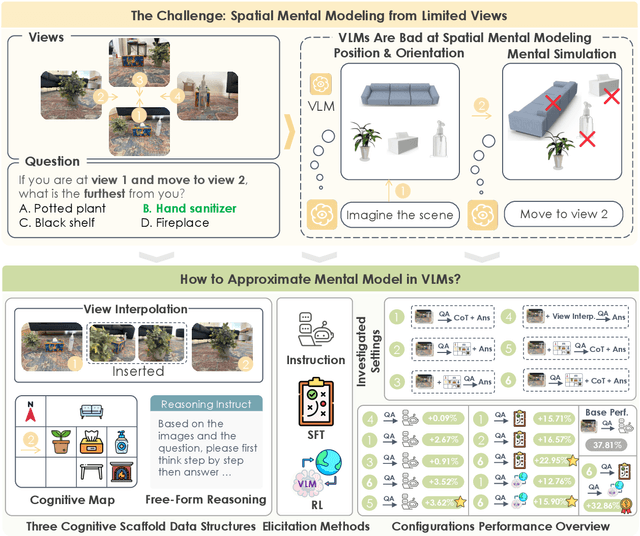
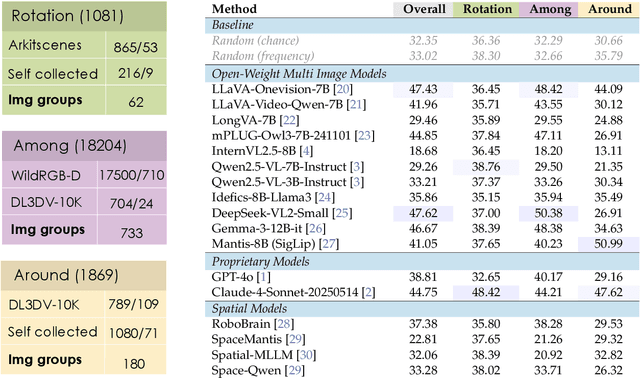
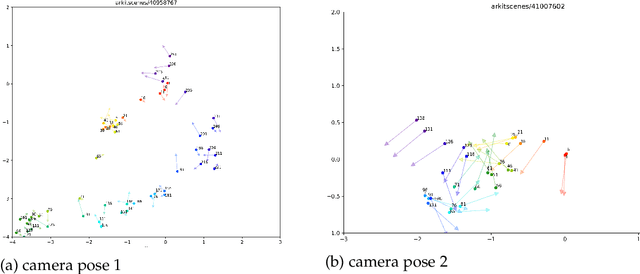
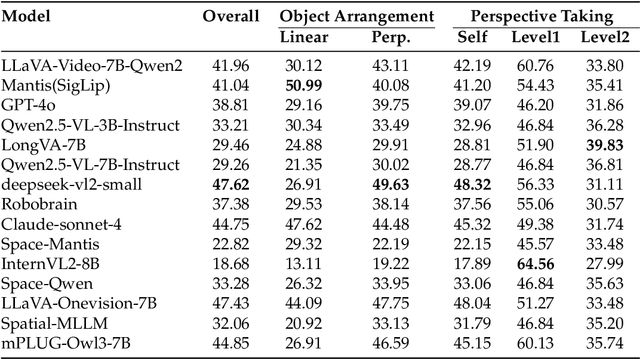
Abstract:Can Vision Language Models (VLMs) imagine the full scene from just a few views, like humans do? Humans form spatial mental models, internal representations of unseen space, to reason about layout, perspective, and motion. Our new MindCube benchmark with 21,154 questions across 3,268 images exposes this critical gap, where existing VLMs exhibit near-random performance. Using MindCube, we systematically evaluate how well VLMs build robust spatial mental models through representing positions (cognitive mapping), orientations (perspective-taking), and dynamics (mental simulation for "what-if" movements). We then explore three approaches to help VLMs approximate spatial mental models, including unseen intermediate views, natural language reasoning chains, and cognitive maps. The significant improvement comes from a synergistic approach, "map-then-reason", that jointly trains the model to first generate a cognitive map and then reason upon it. By training models to reason over these internal maps, we boosted accuracy from 37.8% to 60.8% (+23.0%). Adding reinforcement learning pushed performance even further to 70.7% (+32.9%). Our key insight is that such scaffolding of spatial mental models, actively constructing and utilizing internal structured spatial representations with flexible reasoning processes, significantly improves understanding of unobservable space.
One Trajectory, One Token: Grounded Video Tokenization via Panoptic Sub-object Trajectory
May 29, 2025Abstract:Effective video tokenization is critical for scaling transformer models for long videos. Current approaches tokenize videos using space-time patches, leading to excessive tokens and computational inefficiencies. The best token reduction strategies degrade performance and barely reduce the number of tokens when the camera moves. We introduce grounded video tokenization, a paradigm that organizes tokens based on panoptic sub-object trajectories rather than fixed patches. Our method aligns with fundamental perceptual principles, ensuring that tokenization reflects scene complexity rather than video duration. We propose TrajViT, a video encoder that extracts object trajectories and converts them into semantically meaningful tokens, significantly reducing redundancy while maintaining temporal coherence. Trained with contrastive learning, TrajViT significantly outperforms space-time ViT (ViT3D) across multiple video understanding benchmarks, e.g., TrajViT outperforms ViT3D by a large margin of 6% top-5 recall in average at video-text retrieval task with 10x token deduction. We also show TrajViT as a stronger model than ViT3D for being the video encoder for modern VideoLLM, obtaining an average of 5.2% performance improvement across 6 VideoQA benchmarks while having 4x faster training time and 18x less inference FLOPs. TrajViT is the first efficient encoder to consistently outperform ViT3D across diverse video analysis tasks, making it a robust and scalable solution.
H2R: A Human-to-Robot Data Augmentation for Robot Pre-training from Videos
May 17, 2025Abstract:Large-scale pre-training using videos has proven effective for robot learning. However, the models pre-trained on such data can be suboptimal for robot learning due to the significant visual gap between human hands and those of different robots. To remedy this, we propose H2R, a simple data augmentation technique that detects human hand keypoints, synthesizes robot motions in simulation, and composites rendered robots into egocentric videos. This process explicitly bridges the visual gap between human and robot embodiments during pre-training. We apply H2R to augment large-scale egocentric human video datasets such as Ego4D and SSv2, replacing human hands with simulated robotic arms to generate robot-centric training data. Based on this, we construct and release a family of 1M-scale datasets covering multiple robot embodiments (UR5 with gripper/Leaphand, Franka) and data sources (SSv2, Ego4D). To verify the effectiveness of the augmentation pipeline, we introduce a CLIP-based image-text similarity metric that quantitatively evaluates the semantic fidelity of robot-rendered frames to the original human actions. We validate H2R across three simulation benchmarks: Robomimic, RLBench and PushT and real-world manipulation tasks with a UR5 robot equipped with Gripper and Leaphand end-effectors. H2R consistently improves downstream success rates, yielding gains of 5.0%-10.2% in simulation and 6.7%-23.3% in real-world tasks across various visual encoders and policy learning methods. These results indicate that H2R improves the generalization ability of robotic policies by mitigating the visual discrepancies between human and robot domains.
Which Agent Causes Task Failures and When? On Automated Failure Attribution of LLM Multi-Agent Systems
Apr 30, 2025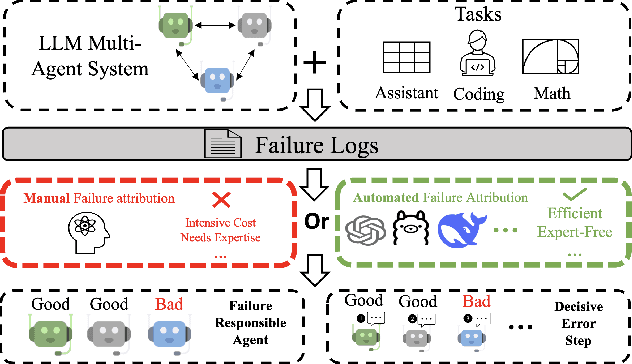
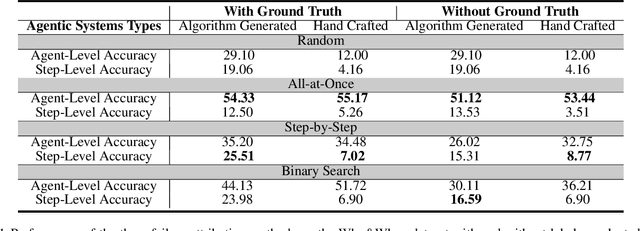

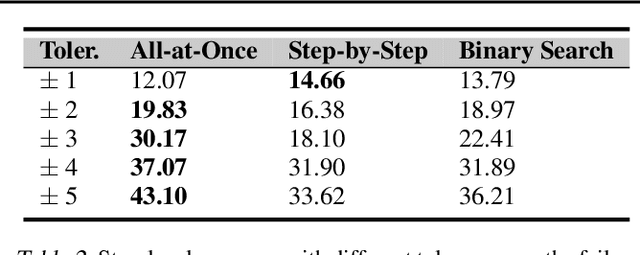
Abstract:Failure attribution in LLM multi-agent systems-identifying the agent and step responsible for task failures-provides crucial clues for systems debugging but remains underexplored and labor-intensive. In this paper, we propose and formulate a new research area: automated failure attribution for LLM multi-agent systems. To support this initiative, we introduce the Who&When dataset, comprising extensive failure logs from 127 LLM multi-agent systems with fine-grained annotations linking failures to specific agents and decisive error steps. Using the Who&When, we develop and evaluate three automated failure attribution methods, summarizing their corresponding pros and cons. The best method achieves 53.5% accuracy in identifying failure-responsible agents but only 14.2% in pinpointing failure steps, with some methods performing below random. Even SOTA reasoning models, such as OpenAI o1 and DeepSeek R1, fail to achieve practical usability. These results highlight the task's complexity and the need for further research in this area. Code and dataset are available at https://github.com/mingyin1/Agents_Failure_Attribution
Nemotron-Research-Tool-N1: Tool-Using Language Models with Reinforced Reasoning
Apr 25, 2025Abstract:Enabling large language models with external tools has become a pivotal strategy for extending their functionality beyond text generation tasks. Prior work typically enhances tool-use abilities by either applying supervised fine-tuning (SFT) to enforce tool-call correctness or distilling reasoning traces from stronger models for SFT. However, both approaches fall short, either omitting reasoning entirely or producing imitative reasoning that limits generalization. Inspired by the success of DeepSeek-R1 in eliciting reasoning through rule-based reinforcement learning, we develop the Nemotron-Research-Tool-N1 series of tool-using language models using a similar training paradigm. Instead of restrictively supervising intermediate reasoning traces distilled from stronger models, Nemotron-Research-Tool-N1 is optimized with a binary reward that evaluates only the structural validity and functional correctness of tool invocations. This lightweight supervision allows the model to autonomously internalize reasoning strategies, without the need for annotated reasoning trajectories. Experiments on the BFCL and API-Bank benchmarks show that Nemotron-Research-Tool-N1-7B and Nemotron-Research-Tool-N1-14B, built on Qwen-2.5-7B/14B-Instruct, achieve state-of-the-art results, outperforming GPT-4o on both evaluations.
Discovering Knowledge Deficiencies of Language Models on Massive Knowledge Base
Mar 30, 2025Abstract:Large language models (LLMs) possess impressive linguistic capabilities but often fail to faithfully retain factual knowledge, leading to hallucinations and unreliable outputs. Understanding LLMs' knowledge deficiencies by exhaustively evaluating against full-scale knowledge bases is computationally prohibitive, especially for closed-weight models. We propose stochastic error ascent (SEA), a scalable and efficient framework for discovering knowledge deficiencies (errors) in closed-weight LLMs under a strict query budget. Rather than naively probing all knowledge candidates, SEA formulates error discovery as a stochastic optimization process: it iteratively retrieves new high-error candidates by leveraging the semantic similarity to previously observed failures. To further enhance search efficiency and coverage, SEA employs hierarchical retrieval across document and paragraph levels, and constructs a relation directed acyclic graph to model error propagation and identify systematic failure modes. Empirically, SEA uncovers 40.7x more knowledge errors than Automated Capability Discovery and 26.7% more than AutoBencher, while reducing the cost-per-error by 599x and 9x, respectively. Human evaluation confirms the high quality of generated questions, while ablation and convergence analyses validate the contribution of each component in SEA. Further analysis on the discovered errors reveals correlated failure patterns across LLM families and recurring deficits, highlighting the need for better data coverage and targeted fine-tuning in future LLM development.
Generate Any Scene: Evaluating and Improving Text-to-Vision Generation with Scene Graph Programming
Dec 11, 2024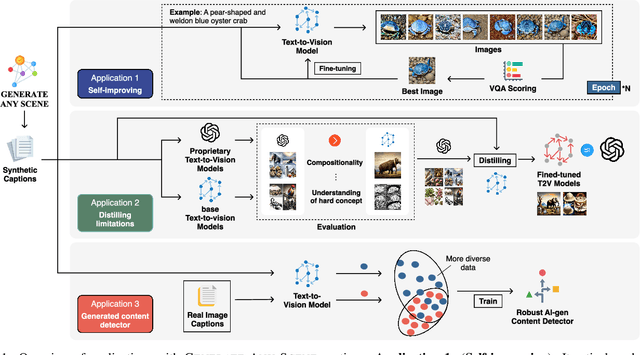
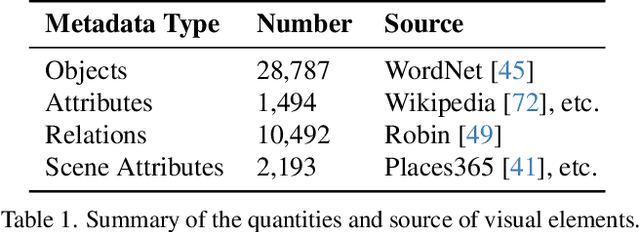
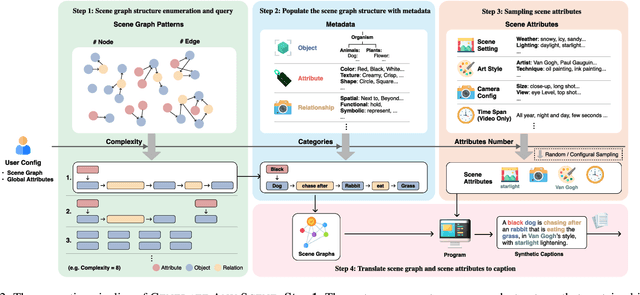
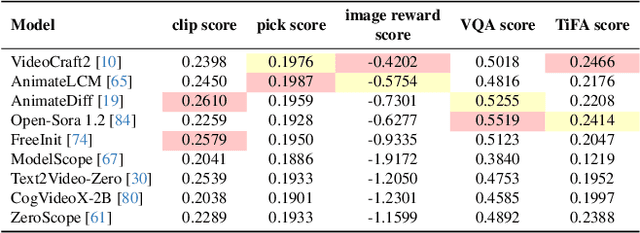
Abstract:DALL-E and Sora have gained attention by producing implausible images, such as "astronauts riding a horse in space." Despite the proliferation of text-to-vision models that have inundated the internet with synthetic visuals, from images to 3D assets, current benchmarks predominantly evaluate these models on real-world scenes paired with captions. We introduce Generate Any Scene, a framework that systematically enumerates scene graphs representing a vast array of visual scenes, spanning realistic to imaginative compositions. Generate Any Scene leverages 'scene graph programming', a method for dynamically constructing scene graphs of varying complexity from a structured taxonomy of visual elements. This taxonomy includes numerous objects, attributes, and relations, enabling the synthesis of an almost infinite variety of scene graphs. Using these structured representations, Generate Any Scene translates each scene graph into a caption, enabling scalable evaluation of text-to-vision models through standard metrics. We conduct extensive evaluations across multiple text-to-image, text-to-video, and text-to-3D models, presenting key findings on model performance. We find that DiT-backbone text-to-image models align more closely with input captions than UNet-backbone models. Text-to-video models struggle with balancing dynamics and consistency, while both text-to-video and text-to-3D models show notable gaps in human preference alignment. We demonstrate the effectiveness of Generate Any Scene by conducting three practical applications leveraging captions generated by Generate Any Scene: 1) a self-improving framework where models iteratively enhance their performance using generated data, 2) a distillation process to transfer specific strengths from proprietary models to open-source counterparts, and 3) improvements in content moderation by identifying and generating challenging synthetic data.
Template Matters: Understanding the Role of Instruction Templates in Multimodal Language Model Evaluation and Training
Dec 11, 2024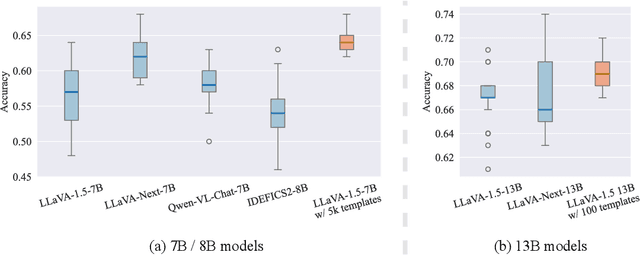
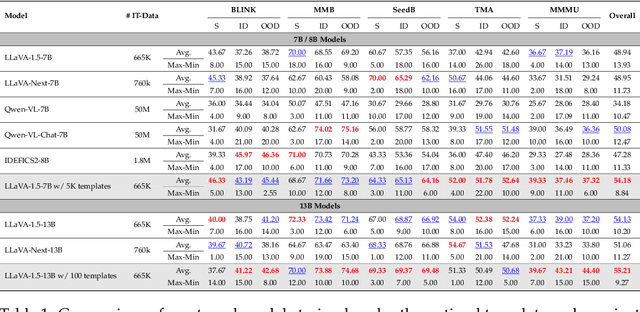

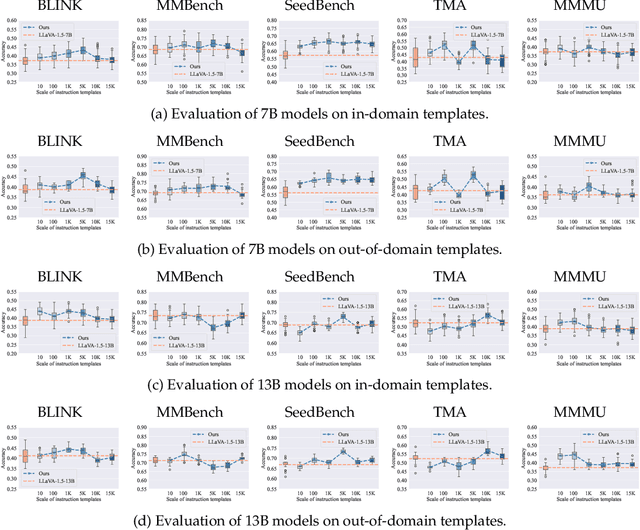
Abstract:Current multimodal language models (MLMs) evaluation and training approaches overlook the influence of instruction format, presenting an elephant-in-the-room problem. Previous research deals with this problem by manually crafting instructions, failing to yield significant insights due to limitations in diversity and scalability. In this work, we propose a programmatic instruction template generator capable of producing over 39B unique template combinations by filling randomly sampled positional synonyms into weighted sampled meta templates, enabling us to comprehensively examine the MLM's performance across diverse instruction templates. Our experiments across eight common MLMs on five benchmark datasets reveal that MLMs have high template sensitivities with at most 29% performance gaps between different templates. We further augment the instruction tuning dataset of LLaVA-1.5 with our template generator and perform instruction tuning on LLaVA-1.5-7B and LLaVA-1.5-13B. Models tuned on our augmented dataset achieve the best overall performance when compared with the same scale MLMs tuned on at most 75 times the scale of our augmented dataset, highlighting the importance of instruction templates in MLM training. The code is available at https://github.com/shijian2001/TemplateMatters .
 Add to Chrome
Add to Chrome Add to Firefox
Add to Firefox Add to Edge
Add to Edge